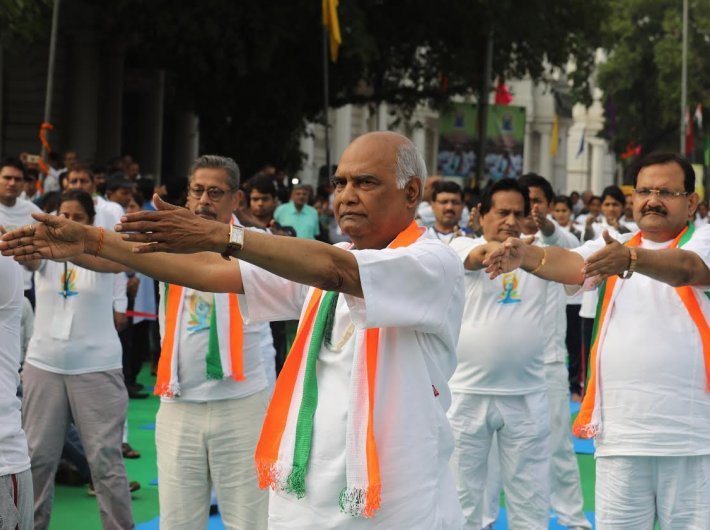PM’s unorthodox ways are aimed at changing political culture and he is aiming well beyond 2019
Ram Nath Kovind is widely tipped to get elected as the 14th president of India. His elevation will not be without surprise. Prior to his nomination as the NDA’s candidate, few in the political circles had any idea that he would emerge as the final choice for the office of the president. The entire process leading the election of the president brings out the manner in which Narendra Modi and his government have functioned. It also sheds some light on what the agenda of the government is likely to be in the run-up to the 2019 general elections and further.
It is now usual for the Modi administration to appoint relatively lesser known persons to high public offices. This trend was first apparent in the cabinet formation, when Smriti Irani was appointed the minister of human resource development (HRD). The HRD ministry is regarded as an important ministry, and is usually given to political heavyweights. Previous HRD ministers include the likes of Kapil Sibal and Arjun Singh in the Congress governments and Murli Manohar Joshi in the Vajpayee government. The trend continued in the appointments of various other high bodies including the governor, chief ministers, and heads of various financial and cultural bodies. The appointment of Yogi Adityanath as the chief minister of India’s largest state, Uttar Pradesh, where the BJP won handsomely, was the latest in the series of appointments to important positions that raised many eyebrows.
By comparison, Kovind has had a long political career. He is the Bihar governor, and has been member of various parliamentary committees earlier. He was the chairman of the Rajya Sabha house committee and served as a member of the parliamentary committee on welfare of scheduled castes/tribes and social justice and empowerment among others.
In choosing Kovind, Modi may have been guided by the desire to preempt any possibility of creating rival centres of power. Given the crucial role that the president can play in the event of an uncertain electoral verdict both in the centre and states, Modi would prefer a friendly occupant in Raisina Hills. Kovind is a veteran BJP man, who has shared amicable relationship with the Sangh. Modi, however, is not the first leader to make political loyalty the touchstone of political appointments. The most common parallel drawn is to Indira Gandhi, who was known to prioritise personal loyalty above all the other criteria.
Appointment of relatively unknown faces has other advantages too. Such appointees are less like to face harsh public scrutiny, enjoy longer honeymoon period and fuel the political rhetoric that the administration values merit above all. In that sense, Kovind’s nomination adds to the credibility of the Modi government, and gives it sheen of non-partisanship.
A second and an equally visible trend under Modi’s leadership is the secrecy with which the decisions are made. It was not just during the demonetisation that very few members of Modi’s cabinet knew about the decision. If reports are to be believed, even the closest aides of Modi were not aware of the nomination of Kovind as the presidential candidate. According to reports published in India Today, Kovind was first shortlisted by party president Amit Shah in the first week of June 2017. It was a closely guarded secret and Kovind confided that he himself was not aware of his nomination till June 17. However, deliberations on all issues including this one are duly carried out. Thus, Shah announced the name of Kovind only after a nearly two-hour-long meeting of the BJP parliamentary board attended by Modi among others. In that sense, the “due process” is always adhered to by the government. But the political circles are kept guessing.
The Modi government, in the last three years in power, has also given considerable importance to ideology. Up to the 2014 elections, the BJP was willing to make tacit compromises and concessions on ideological issues and arrive at a common middle ground. Modi’s campaign during the 2014 elections deliberately avoided all contentious issues both with alliance partners and regional parties. Its electoral strategy deliberately diluted some of its core elements of its ideology such as strong centre, smaller states, influx of refugees, one people, one culture, etc in the interest of making itself “coalitionable” (K Kailash: Economic and Political Weekly, 2014). Modi’s campaign resisted from making direct charges against regional leaders. In Odisha and West Bengal, for instance, it accused the ruling parties without directly attacking their leaders of neglecting development. It focused on highlighting relatively non-controversial issues like development, leadership and governance. The victory in the 2014 election and subsequently in many states including Uttar Pradesh, Assam and Goa has made it confident enough to aim for a systemic change and ideological overhaul.
The Modi-Shah duo realises that continued success of the BJP would depend creating a conducive and supportive ideology for itself. Their vision for BJP goes well beyond 2019, as most imagine. It is a well-known fact that political parties attempt to either retain the existing culture or change it. What is unique about BJP that during its three years in power so far, it has tried to change the nature of India’s political culture. The young, aspiring middle class appears to be ready to experiment with this change at this moment. Whether the personal popularity of Modi coupled with the organisational acumen of Shah is enough to remould the political culture of over 60 years is yet to be seen.
What is more concerning from the point of view of future of Indian politics is that there seems to be no alternative vision to challenge Modi. The opposition appears to lack not just leadership and organisation, but even the vision and the will to challenge the government on its own terms. Even in the case of the nomination of the presidential candidate, the opposition allowed Modi to decide the terms of contest by waiting for the NDA to announce its presidential nominee. The choice of Meira Kumar, though it brought the opposition together, was a reactive one. Kumar, like Kovind, is a dalit leader and belongs to the Hindi heartland.
The presidential election has brought forth once more the hard realities of Indian democracy. An old and hitherto dominant party has lost its social base among the masses. It is bereft of new ideas and unwilling to give space to democracy within the organisation. The smaller regional political parties – important players of the 1990s – have not been able to evolve a new ideology or strategy of mobilising the people and remaining relevant, while the ruling party, riding on the wave of burgeoning middle class desires, creates an unrivalled leader and a new political culture.
Manisha is associate professor, department of political science, SNDT Women’s University, Mumbai.

